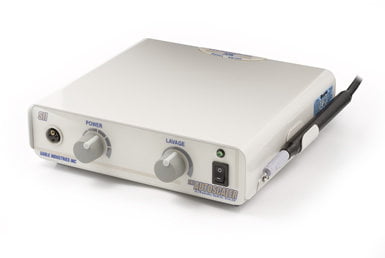Scaling used to be a dental hygienist’s daily grind. But owing to advancements in ultrasonic scaling, the process has become increasingly efficient and effective. Not only is ultrasonic scaling more convenient to the hygienist than scaling with hand instruments, it has numerous benefits to patients’ oral hygiene as well.
What is Ultrasonic Scaling?
An ultrasonic scaler is a power-driven scaling device that utilizes ultrasonic vibration to break up hardened calculus deposits on patients’ teeth. The vibration is driven by a generator converts electricity into ultrasonic waves through piezoelectricity or magnetostriction.
Once activated, the tip of an ultrasonic scaler oscillates at incredible speeds up to 35,000 cycles per second. The hygienist guides the tip from the coronal to the apical of a tooth, pulverizing calculus so it can be washed away by a coolant spray.
Ultrasonic scalers remove plaque through a dual application of mechanical force and cavitation. The vibration of the tip creates pressure waves in the water dispersed as coolant, causing the formation and implosion of atomized gas bubbles. These shockwaves help to disrupt bacterial biofilm and fracture the calculus deposits as they are pounded by mechanical force.
The oscillating tip of an ultrasonic scaler is replaceable, with tips of various shapes and diameter available for different purposes. Thicker tips are generally suitable for use with higher power settings to remove heavier calculus deposits, whereas thin tips are used for light calculus or biofilm removal. In any case, hygienists should read the manufacturer’s directions as to a tip’s proper usage.
Benefits to Ultrasonic Scaling
Ultrasonic scaling is highly effective in removing subgingival/supragingival calculus from teeth without damaging roots or gum tissue. Other benefits to ultrasonic scaling include:
- Using an ultrasonic scaler, hygienists can remove calculus from pockets between teeth and gums at probing depths that are unreachable with hand tools (4mm or greater.)
- Ultrasonic scalers have replaceable, specially-designed tips that can penetrate difficult nooks and corners.
- Since there are no sharp cutting edges and no ‘scraping’ sound, many patients find ultrasonic scaling is more comfortable than scaling with hand dental instruments.
- Scaling using an ultrasonic scaler is faster than hand scaling, allowing more time for the hygienist to speak to and educate the patient at the end of the appointment.
- Ultrasonic scaling is more ergonomically sound, as its power-driven vibration replaces the need to exert lateral pressure on the instrument to remove plaque.
These benefits have made ultrasonic systems like the Cavitron-Compatible Autoscaler the method of choice for many dental practices, replacing other methods power-driven scaling.
However, ultrasonic scalers are not suitable for all patients. Notably, ultrasonic scaling should never be used on or near a person with a cardiac pacemaker. Additionally, some patients are apprehensive of power-driven scalers and prefer that their hygienist provide scaling using hand instruments.
Get Up to Speed with More Dentistry News & Insights
Ultrasonic Scaling Technologies: Magnetostrictive vs. Piezoelectric Scalers
Ultrasonic scalers are driven by one of two types of generators: magnetostrictive or piezoelectric. Both can be effective, but there is a learning curve associated with each.
A piezoelectric ultrasonic scaler uses transducers to convert electricity into mechanical energy using materials like quartz crystals. The device sends electrical energy to ‘activate’ the material within the handpiece and vibrate the instrument tip at 28,000 to 35,000 cycles per second. The tip vibrates in a back-and-forth motion and only the lateral sides are active.

Magnetostrictive ultrasonic scalers like the Autoscaler generate vibratory motion by transferring electrical energy to metal components in the handpiece. The tip operates in an elliptical motion at 25,000 to 30,000 cycles per second. Unlike piezoelectric scalers, all sides of the tip (lateral, face and back) are active in a magnetostrictive device.
Questions? For more information about ultrasonic scaling or Sable’s Cavitron Compatible Autoscaler, contact our team of dental experts. We’re always happy to help!
Discover Full Autoscaler Features, Benefits & Specifications


